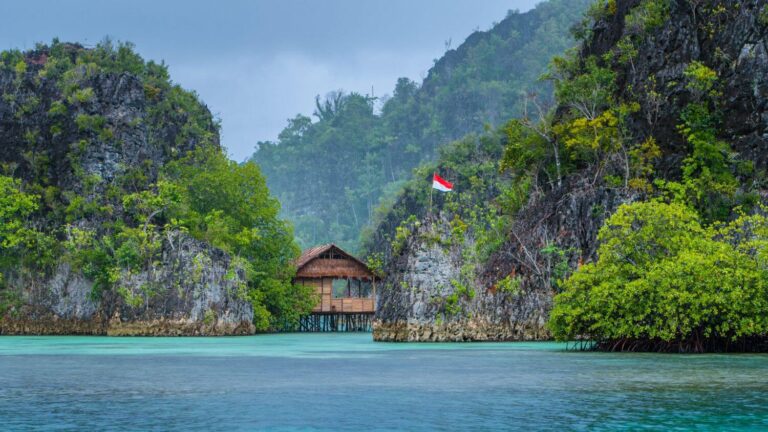
RAJA AMPAT by Diving Squad - Regions, Seasons, Guide & Ideas
Raja Ampat: it’s a name hushed on the lips of scuba fanatics and marine scientists alike.
Currently viewed as the final frontier of scuba diving; the global hotspot for marine biodiversity, this far east Indonesian province is isolated, unspoilt and untouched from the rest of the world.
Scuba Diving Raja Ampat is a unique experience – it’s one of the best places in the world to see high numbers of reef sharks and manta rays and is also home to rare endemic species such as the tasselled wobbegong shark!
With vast and pristine coral reefs that are fed by the largest movement of water in the world; the Indonesian flowthrough, Raja Ampat is also teaming with reef sharks, turtles and countless macro critters like pygmy seahorse, nudibranch and ghost pipefish, to name a few.
Plus, divers have an excellent chance of spotting marine mammals like dolphins, whales and even dugong! No wonder that so many divers currently consider Raja Ampat to be the best place to currently scuba dive in the world.
As well as diving, there are other truly unique experiences to be had here: Swimming in lakes filled with non-stinging jellyfish, witnessing the stunning cliff islands of the northern region and traditional village visits are all on the cards.
Do be informed however, that Raja Ampat is divided into three unique regions – north, central and south.
Each region varies considerably in terms of the aquatic landscapes and marine lifeforms it offers as well as the extra activities that are possible there.
Which regions you get to visit will depend on how you choose to dive there – via liveaboard or resort; as well as which liveaboard or resort that you choose.
Amongst the many options, there’s considerable variation in terms of dive itineraries, routes travelled, price and overall vibe.
Starting to sound complicated? Don’t worry about it! This article breaks down everything you need to know about how to get the absolute best out of your Raja Ampat diving adventure, what to expect from the various diving regions there and everything else you’ll need to know.
Let’s dive in:
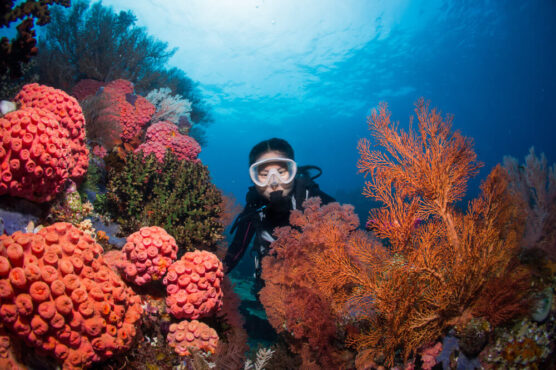
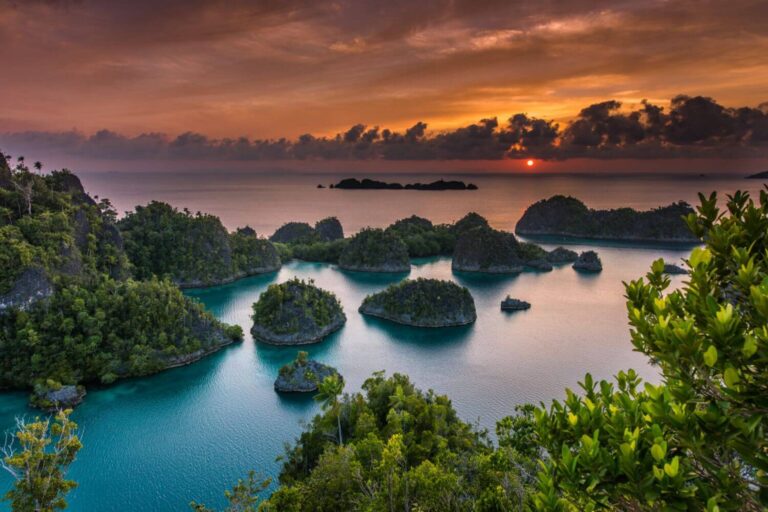
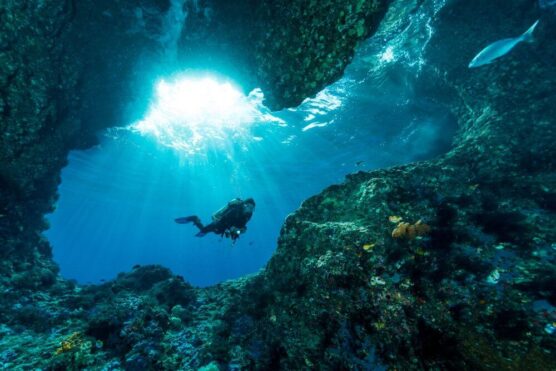
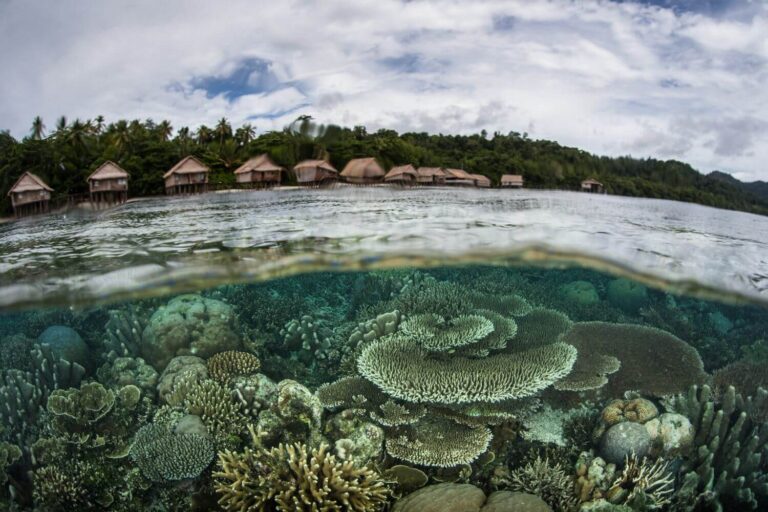
Regions of Raja Ampat
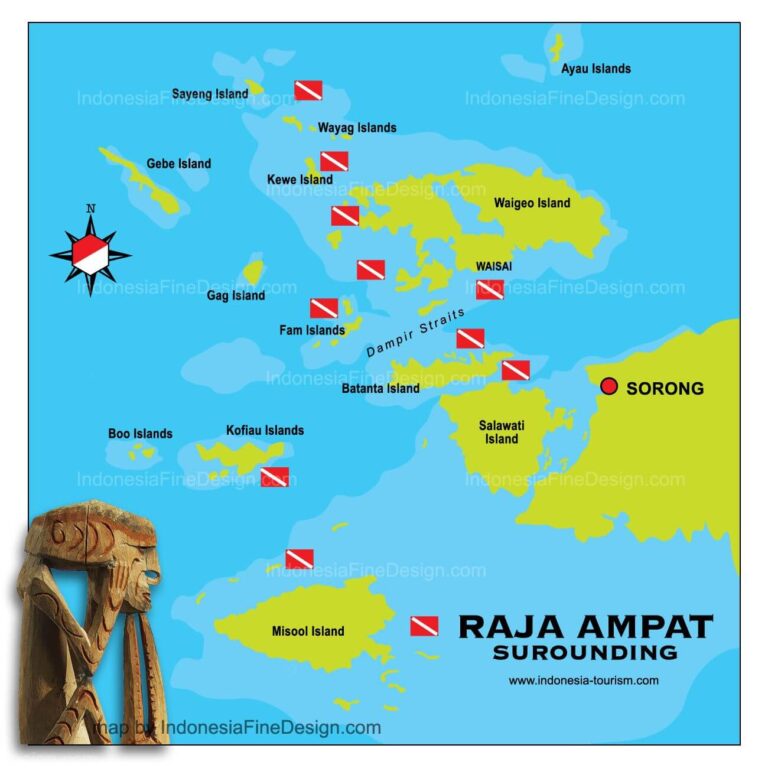
Attention! When referring to the regions of Raja Ampat, this is in relation to the various islands and areas that are within close proximity to each other and subsequently are often combined into itineraries by dive operators.
Do note that some dive operators only divide Raja Ampat into North and South. In this instance, generally a “north trip” will explore the central and north regions described below, whereas a “south trip” will explore the central and south regions.
Finally, Raja Ampat is a huge archipelago with many hundreds of tiny islands, shoals and cays – not all of these has been listed below! However, all the major areas are described and it is from these that you will explore the various other islets and shoals.
#1 Central Raja Ampat
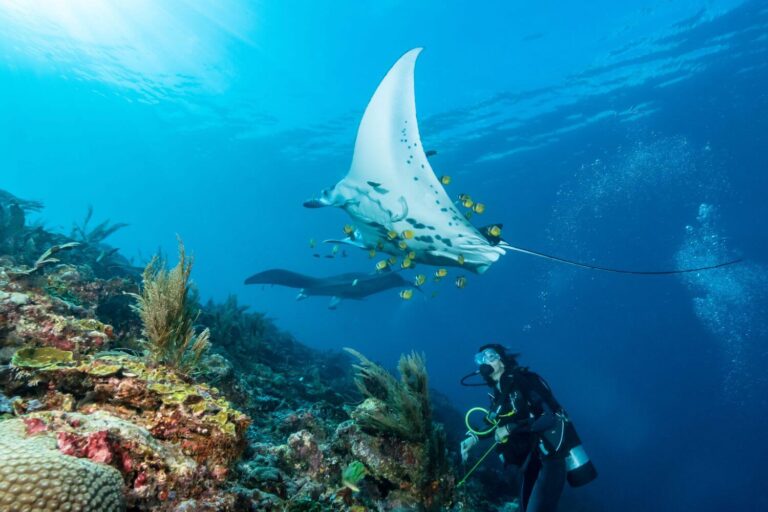
- Comprised of the dive sites between Batanta south Waigeo as well as several smaller islands including the tiny Jef Fam island group.
- Regarded as the best place in Raja Ampat to dive with multiple manta rays!
- Because the Dampier Strait flows between Batanta and Waigeo, the ocean current is at it’s strongest around the central region, resulting in many strong drift dives!
- There’s also some great muck diving as well as a few WW2 wreck dives like the P47 Thunderbird plane wreck!
- Around the central region is also where you have the best chance of spotting dolphins and whales (seasonal) as well as the occasional dugong.
- Generally speaking, multi day dive trips always explore central Raja Ampat before making their way to the north or southern regions.
Dampier Strait:
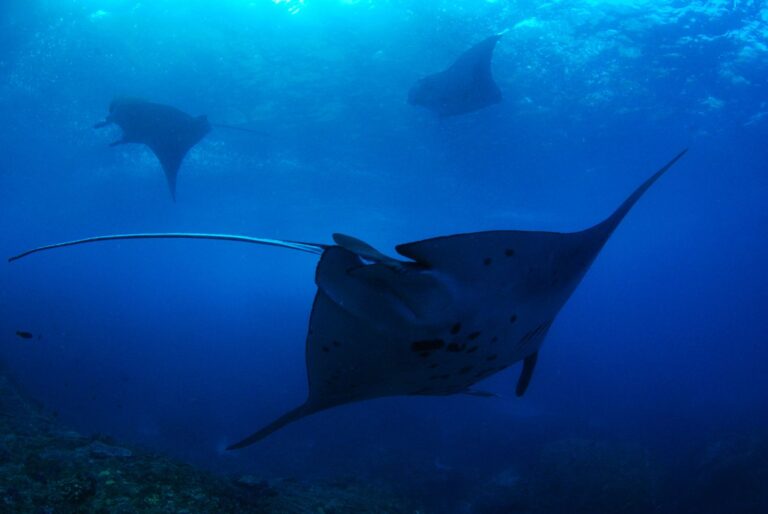
The Dampier Strait stirs up nutrients from the deep sea to and carries them onwards to feed a spectacular variety of hard and soft corals as well as sponges, which together form beautiful and varied reefs.
These reefs attract many trevallies, bump head parrotfish, sweetlips as well as innumerable reef fish. In slightly deeper waters, there are countless barracudas, reef sharks, turtles and manta rays.
The Dampier is at it’s most concentrated as it flows between north Batanta and South Waigeo. As a result, between these two islands (2 of the four kings), there are some of the best drift dives in all of Raja Ampat as well as the best place for spotting frequent, high numbers of manta rays.
The Dampier Strait is also one of the best areas in Raja Ampat to spot whales, which is why whale watching liveaboards such as Pinditio, spend much of their time looking for cetaceans in the central region.
South Waigeo:
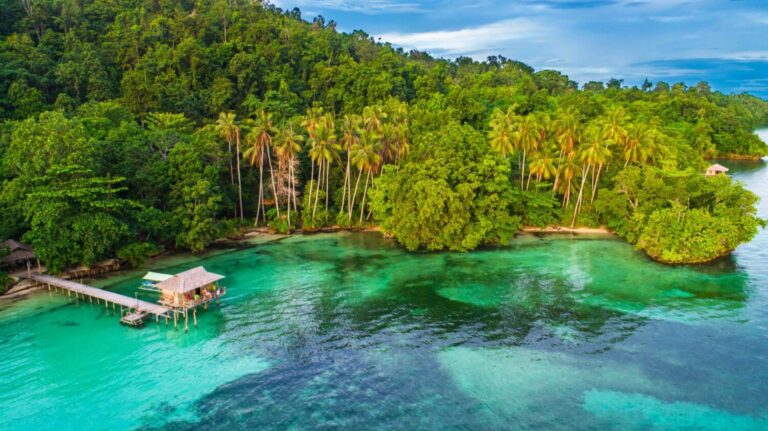
Waigeo is the largest of the Four Kings. Waigeo’s southern coast is exposed to the full force of the Dampier Strait and as a result features are some of the most epic drift dives in Raja Ampat.
Perhaps most famous of all is “Manta Ridge”, a pelagic cleaning station that is renowned for being one of the most places in the world to spot manta rays in high numbers. On average divers see around 5 of the creatures on a single dive, but it’s not uncommon to witness 20 or even up to 30!
Teeming with terrestrial wildlife and epic scenery, Waigeo is also a great place to explore and most diving liveaboards and some resorts can offer various extra activities for those fancy setting foot on land for a while!
There are a number of traditional villages around Waigeo’s southern coast such as Arborek Village where you can both dive around the village pier as well as visit the village itself, to see the peoples local way of living.
One can also possible to go viewpoint trekking for some insane cliff top views of the bays as well as look for birds of paradise. If you do plan on going trekking, check out this article on hiking boots for plantar fasciitis!
Mansuar:
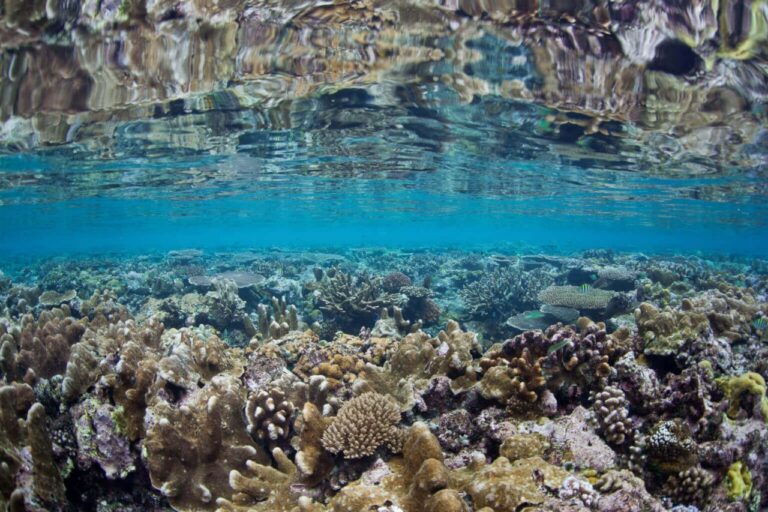
This is a very narrow strip of island, barely 1km wide and only a few km long. It is located between south Waigeo and North Batanta, but is closest to Waigeo. There is a great viewpoint at the top! There are a number of homestays along it, most of which offer scuba diving. Mansuar island is right next to Cape Kri, which is encrusted in coral all the way down.
This spectacularly colourful coral wall is a beacon to massive schools of fish of every kind. Dr. Gerald Allen documented 374 species of fish here in a single dive, a world record!
If you take the time to examine that blue water a little more closely, you’ll likely spot grey reef sharks, barracuda, tuna, and possibly mantas.
Bantanta:
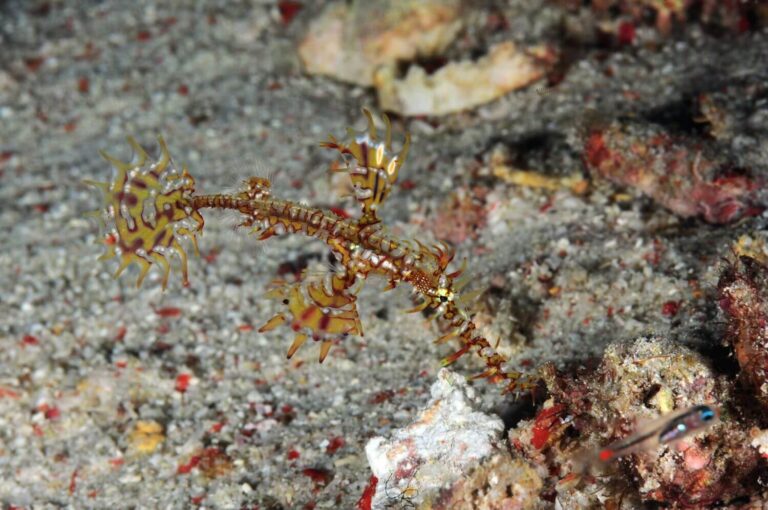
The dive sites north of Batanta are similar to South Waigeo in that they are very exposed to the strong currents of the Dampier Strait, resulting in many adrenaline pumping drift dives further out.
However, the dive sites around south Batanta; between it and north Salawati – are different to most of the rest of Raja Ampat. That’s because rather than offering spectacular coral reef, they are generally characterised by sloping sand bays with algae patches and coral rubble.
At first glance one might be underwhelmed, but that’s only if they’ve never been muck diving before! To the trained eye there are many weird and wonderful critters awaiting discovery, such as as pipefish, seahorses, nudibranch and seahorses. Batanta island is normally the first stop on diving liveaboards.
Jef Fam Islands:
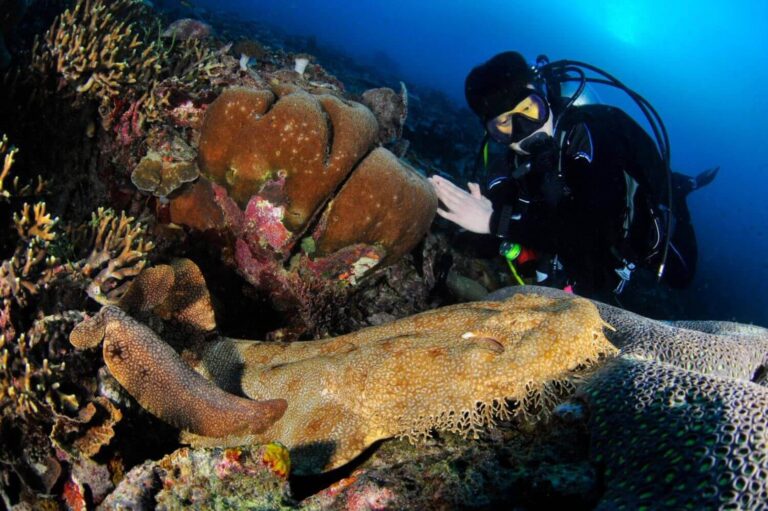
A cluster of small limestone islands and islets that lie west of Batanta island, the Jef Fam islands may be tiny, but don’t be deceived! Defined by shallow aquamarine bays, lagoons, beaches, cliffs and coves; these tiny islets are one of the best places to discover Raja Ampat’s hard coral at it’s finest!
With 75% of all the world’s known hard coral species being found at Raja Ampat, there is a staggering array of diversity making for some truly beautiful colour blends.
In particular, look out for yellow sheet corals, green cabbage patch corals, orange staghorn coral and stunning pink mushroom corals! Darting and diving among them, you’ll also spot countless anthias fish, in just as varied an assortment of colours.
There are cooler creatures still. The Jef Fam islands are typically regarded as the most likely placed to spot the tasselled wobbegong shark, which is rarely seen outside of New Guinea and Australia!
Also keep an eye out for white banded sea snakes, which are usually seen hunting over the cabbage patch corals. There’s also many angelfish and slender fusiliers as well as giant clams, which can be hundreds of years old!
#2 North Raja Ampat
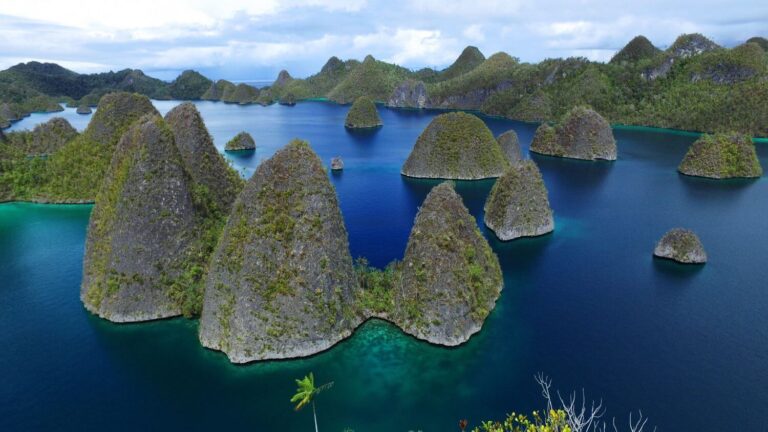
- Without a doubt, the most beautiful and dramatic terrestrial landscape in all of Raja Ampat.
- More remote and hard to reach than the central region!
- Comprised of dive sites off upper west waigeo as well as far northern islands: Pulau Kawe and Wayag islands.
- Good mix of macro marine life such as nudibranch and seahorses as well as larger marine life like big fish species and reef sharks.
- Dozens of friendly black tip reef sharks off the jetty of Wayag Ranger Station makes for epic snorkelling!
Upper West Waigeo:
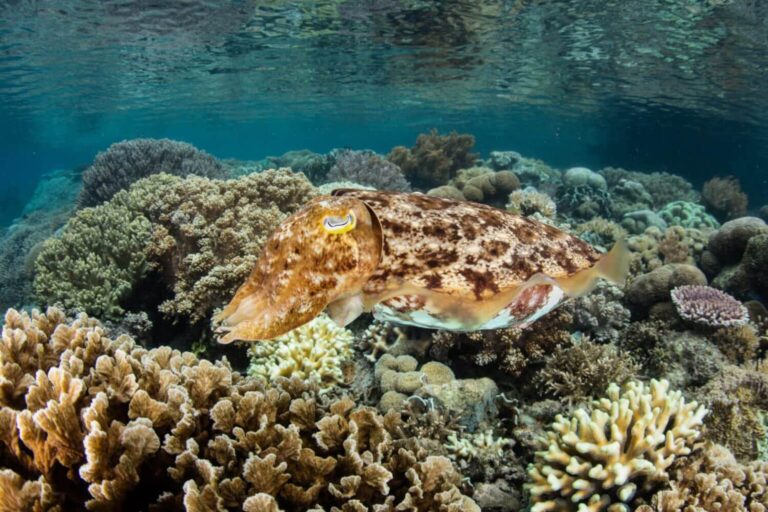
The lower half and most easily reachable part of Raja Ampat’s north region, is comprised of the waters off and around upper west Waigeo. One of the major areas here is Sel Pel Bay, which has many awesome dive sites, a favourite of which is Bird Wall as it offers a great chance to enjoy both macro and large critters.
Divers will encounter many small bommies reefs and rocky areas that are scattered along the bay’s slope and these provide a home to many awesome macro critters like cuttlefish, sailor shrimps, pipefish and a variety of unusual nudibranches including Funebris and Nembrotha.
On the other end of the spectrum, look out for big napoleon wrasse, fusiliers, jacks and reef sharks! The shallows are equally interesting and underwater photographers with a trained eye can spot pygmy sea horses and sea dragons as well as green sea turtles.
At greater depths there are many white tip and black tip reef sharks as well as the occasional tasselled wobbegong shark!
Kawe Island:
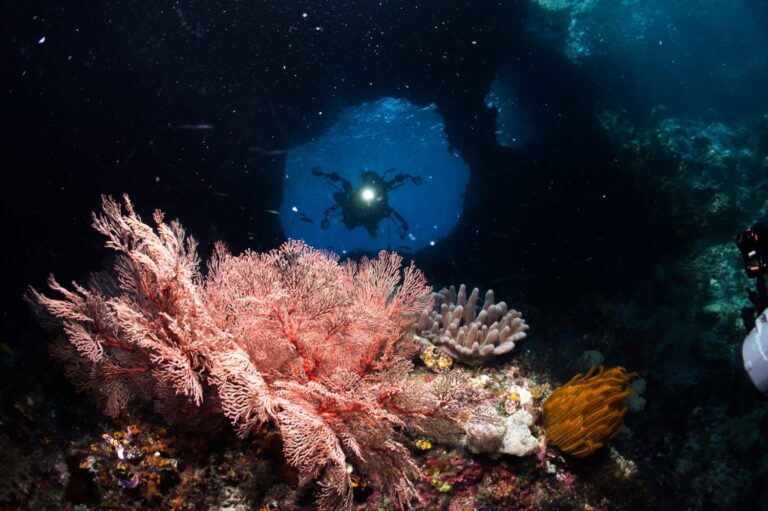
North of waigeo lies Kawe, an uninhabited island that sits right across the Equator. The waters around Kawe are home to a number of stellar dive sites, but the most famous of these are currently Eagle Rock, Black Rock and Chango.
Eagle Rock is great for manta rays as well as a large maze like configuration of boulders, that makes for an epic labyrinth of exploration and another good place to spot wobbegong sharks.
Black rock is well known for the high density of reef fish found here as well as it’s ancient black coral bushes. However, Chango is the most exciting to dive as this site holds a vast playground of tunnels and giant boulders, which make for awesome exploration by the adventurous diver!
Wayag Islands:
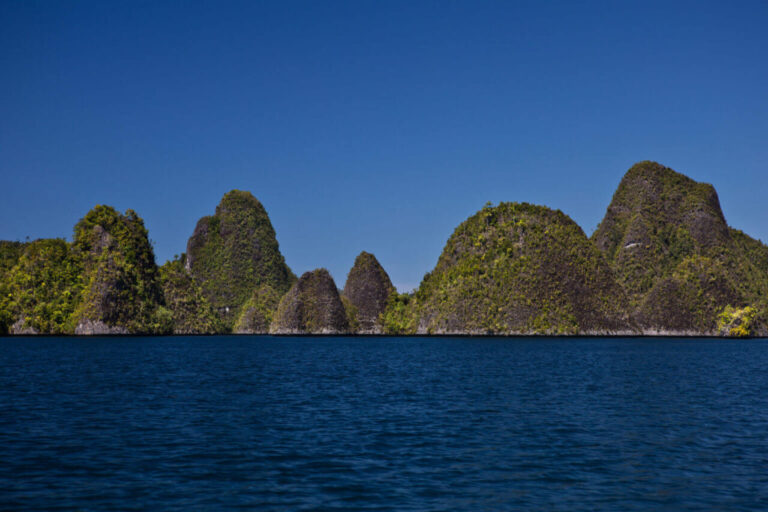
Located at the northernmost point of the archipelago the uninhabited Wayag islands, which are a national park, are used in most iconic photography for Raja Ampat.
Anytime you’ve seen a Raja Ampat picture of conical, jungle coated cliffs towering over crystal clear waters; chances are it was taken around the stunning wayag islands!
These islands have no resorts or homestays, meaning they can only be reached via liveaboard or a long day trip, but the long journey is well worth the effort.
Underwater divers can encounter countless reef sharks. Those who visit the Wayag Ranger Station will notice dozens of black tip reef sharks circling round the shallows of the jetty – you need only stand knee deep in the water to get up close with them, giving snorkelers a rare opportunity to see many reef sharks up close.
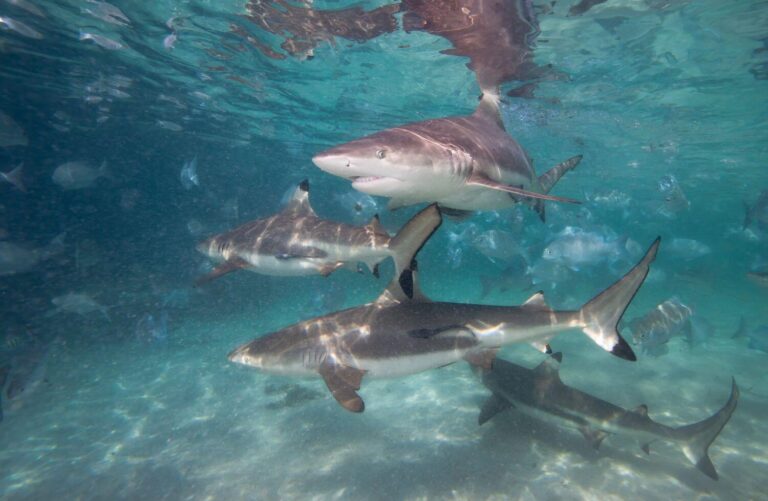
#3 South Raja Ampat
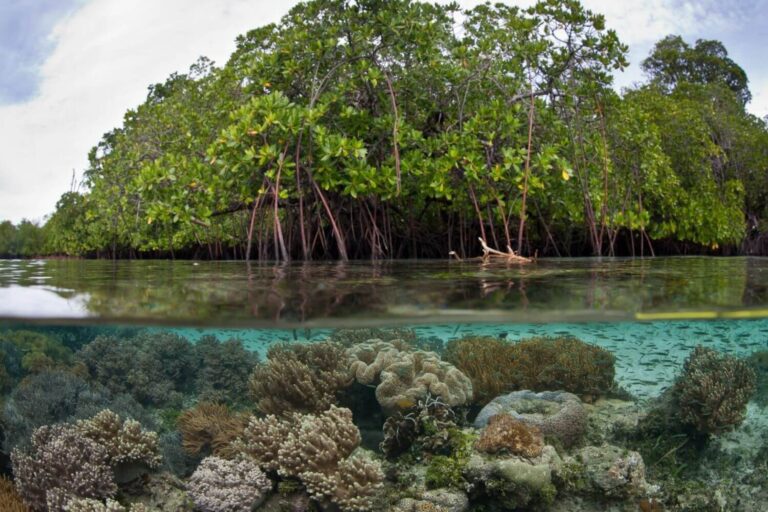
- People have been diving around south Raja Ampat for considerably less time than they have around the north and central region.
- This is hands down best place in Raja Ampat for high numbers of sharks and rays!
- This is the most seldom visited part of Raja Ampat. Usually, it’s only accessible via liveaboard.
- Misool has 3 lakes filled with non-stinging jellyfish that you can swim with!
Raja Ampat’s elusive south is the most newly discovered region for scuba divers and is comprised of Misool island as well as many tiny islets, which are most densely concentrated off Misool’s southeastern corner. This is the least explored region of Raja Ampat for scuba divers, with new dive sites still being discovered here!
The southern region is known for it’s high abundance of sharks including reef sharks and rarer species like hammerhead sharks, wobbegong sharks and whale sharks to! There are also huge grouper, snappers and giant barracuda. In addition to many epic reefs that can be drift dived, divers can also discover a number of cleaning stations which are frequented by manta rays.
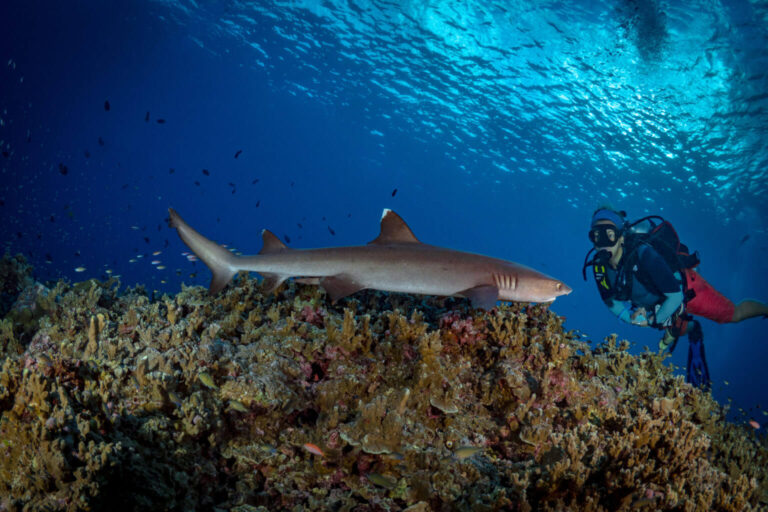
That said, large pelagic species and epic drift dives aren’t the only defining feature of the southern region. Around Misool’s blue water mangrove lagoons and bays; there’s a number of underwater caves and swim throughs that are adorned with colourful sessile marine life, awaiting exploration by the boldest of divers.
Misool also has three freshwater lakes that are filled with large, non-stinging jellyfish, which you can witness up close by swimming with them!
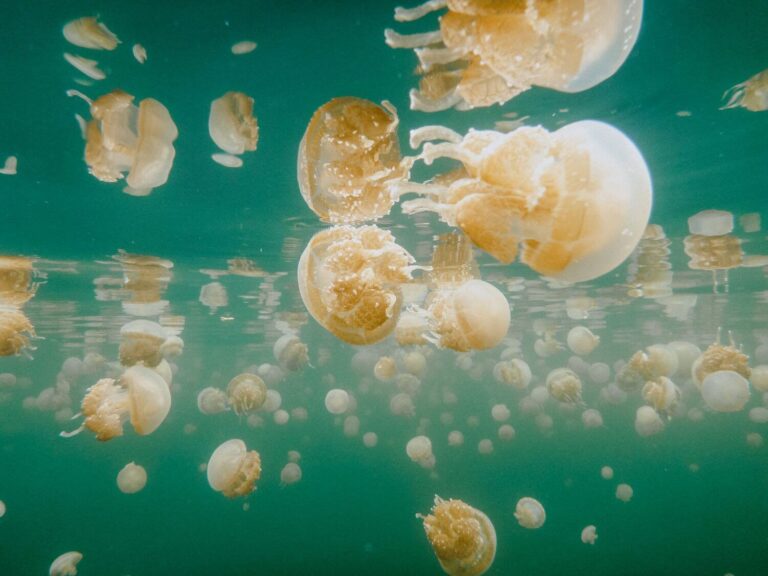
When to Dive Raja Ampat:
October-April: This is the best time to dive at Raja Ampat as wind and rain are minimal, whilst overall climate and visibility are great! Manta Ray activity also peaks around this time. Plus, during the months of October and February, you can go whale watching. All dive operators run during between October – April.
May – September: Between these months, the winds and rains pick up drastically, resulting in choppier waters and significantly reduced visibility. As a result most liveaboards (see next section below!) do not operate during these months.
How to Dive Raja Ampat:
Option 1 - Liveaboard:
This is where you live aboard a boat for anywhere from a few days to several weeks, whilst being toured around the best and most hard to access diving sites in the region; many of which can only be accessed in this way. The boat’s crew will include dive guides, naturalists and chefs.
Liveaboards vary a lot! Some are more like backpacker hostels on water with basic amenities and dorm style accommodation – they can be very affordable indeed especially with the price of meals also being included. Other liveaboards are huge vessels with lavish features like luxury cabins, spas and jet skis.
As we’ve now seen, there are many different routes that can be travelled through Raja Ampat. Most liveaboards tour several different routes, although some offer a great variety of options than others. Plus,, some liveaboards start diving in Raja Ampat before touring onwards elsewhere in nearby Indonesia.
Liveaboards also include extra activites such as village visits, treks and watersport activites. Within Raja Ampat there are dozens of different liveaboards operating, all of them varying a lot in terms of price, boat facilities, route, trip length and overall vibe.
For a full breakdown of the very best of these, as well as brutally honest reviews and customer feedback, you can check out this Best Raja Ampat Liveaboards Reviews Page.
A favourite raja ampat liveaboard is the raja ampat aggressor.
Option 2 - Diving Resort / Homestay:
Most of these are concentrated around the central Raja Ampat region. Although they can make day trips towards south or north Raja Ampat, they won’t be able to explore these regions in their entirety and some dive sites you simply can’t access from any resort.
That said, if you’re a total beginner and you want to learn to scuba dive at Raja Ampat, generally it’ll be easier to do so at a diving resort or homestay, because you can take things at your own pace and ask to only be taken to shallow, easy dive sites, whereas a liveaboard will tour a wide range of dive sites, many of them requiring advanced open water certification to participate in (although a small selection of liveaboards are beginner friendly!). A few recommendations are:
- #1 Raja Ampat Dive Lodge – This simplistic resort is based in central Raja Ampat on the tiny island of Mansuar island, just south of Waigeo and next to the famous cape kri; a coral encrusted wall dive. It is a very laid back place on a tiny, picturesque island that has a great viewpoint at the top.
There’s a range of accommodation options for various budgets. Between dives, you can chill on the tranquil pier with a beer in hand as you watch reef sharks in the shallows or swing from the beach in one of the hammocks. Check it out! - #2 Sea Fans Homestay – Located off west Waigeo, on the tiny island of Palua Minyaifuin, Sea Fans is in a particularly scenic and off the beaten track destination – very few other Raja Ampat resorts are as far north as this! In addition to diving, guests can also embark on a number of cool nature treks as well as explore the beautiful far north islands of Kawe and Wayag on a day trip. Click here to find out more.
- #3 Misool Eco Resort – Currently, the only south Raja Ampat dive resort. Misool Eco Resort is also one of the most environmentally conscious of all dive resorts, with much of it’s funds going towards the upkeep of ranger patrols to prevent illegal and unsustainable fishing. Read about Misool Eco Resort.
Can Beginners Dive at Raja Ampat?
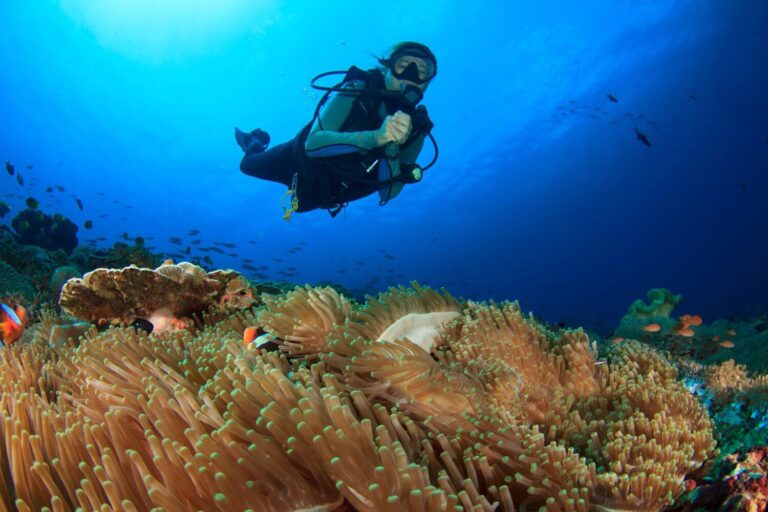
A great many of the dive sites at Raja Ampat are strong drift dives, due to the very same Dampier Strait that makes this region so rich in marine biodiversity in the first place. There’s also cave dives, deep wall dives and some superb opportunities for night diving. As well as a few wreck dives sprinkled in for good measure.
Because of this, it’s strongly recommended that you have your advanced open water certification in order to be able to appreciate the full scope of the awesome variety of dives here. So long as you do have this, you’ll be good to go!
But don’t worry if you simply haven’t dived in a while and need to refresh your scuba skills – it’ll be easy to arrange a half day long scuba refresher course with a liveaboard or dive resort.
Technically, if you email some of the dive resorts or homestays in advance, it should be possible to arrange your open water certification training with them there.
Most Raja Ampat liveaboards require you to have your advanced open water cert – but a fair few only require that you have your open water cert! However, if this is the case, you may be asked to sit out on some dives that you’re not trained for. With a few of the liveaboards it is possible to undergo your open water cert training with them! Check out this page for more details!
Getting There:
You’ll need to get to Sorong. There’s no direct international flights here, but you can fly in via Jakarta, Makassar, Ambon or Manado. I usually book my flight tickets on Skyscanner.
Do note there are not ATM’s in Sorong, so make sure you have plenty of cash before hand!
If you’re embarking on a diving liveaboard, the rest of your trip will be arranged for you as you’ll get picked up from Sorong airport and transferred to the destination it departs from.
However, if you are going to a dive resort / homestay, you’ll need to get from Sorong’s airport to Sarong Harbour (about a 20 minute taxi ride) and take a ferry to Wasai, the capital city on the main Raja Ampat island of Waigeo.
Wasai is the jumping off point to the various resorts in Raja Ampat. You can reach these via speedboat, which can be arranged by your diving resort if you speak to them beforehand – just send a friendly email!
Raja Ampat Ecology, Geography & History in a Clamshell:
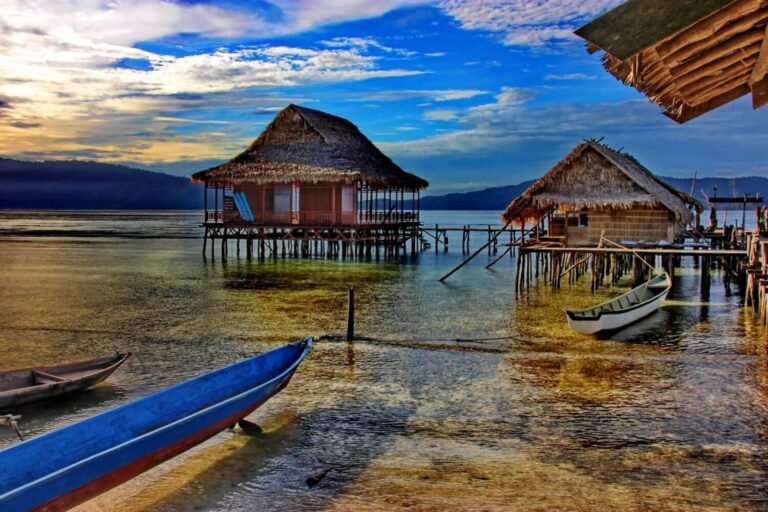
Raja Ampat is a remote and isolated Indonesian archipelago, located off the northwestern tip of Papua: the western half of New Guinea. Translating to “The Four Kings”, it’s actually comprised of hundreds of islets, cays and shoals surrounding the four main islands of Misool, Batanta, Waigeo and Salawati, plus several smaller islands like Gam, Kawe and Wayag!
This is a sparsely populated region, indeed many of the smaller islands are entirely uninhabited, whereas on most of the others, there are only small villages, where the primary lifestyle is traditional fishing. Historically, Raja Ampat was part of the Sultunate of Tidore; an influential kingdom from Maluku.
Due to the fact that this tiny archipelago is so isolated from the rest of the world – being only a short distance from Australia, the province has always remained under-developed. Currently, only Waigeo island has any modern infrastructure and this is mostly restricted to Wasai, the regency’s tiny capital.
Upon escaping Wasai by boat and venturing outwards to explore Raja Ampat, one encounters a magnificent world of towering cliffs and uninhabited islands, coated in lush green jungle and surrounded by crystal clear waters, that serve as windows into the flourish of marine animal activity over the vibrant coral reefs below.
Best of all for divers; Raja Ampat lies within the heart of the Coral Triangle, a marine area that despite covering only 1% of the planet’s surface, contains 30% of the worlds’ coral species and 76% of all known hard coral species! In fact, there is a lot of scientific evidence to suggest that Raja Ampat contains the greatest marine biodiversity within the whole of the coral triangle and thus the entire world!
This is due to the archipelago’s tropical climate, it’s geographic location – surrounded on all sides by the rest of the Coral Triangle, low human population & lack of industrial development and perhaps most importantly – the Indonesian flowthrough, a colossal ocean current that passes between the Raja Ampat archipelago as several smaller ocean currents, the largest of which is the Dampier Strait; which passes between Waigeo and Batanta Islands, right at the centre of the archipelago.
The Dampier Strait and these other currents churn up nutrients from the deep sea and carry them through the waters of Raja Ampat, resulting in many large and healthy atoll, patch, fringe and barrier reefs throughout.
These are comprised of countless hard and soft coral species as well as sponges which come together to form beautiful reefs in a dazzling array of colours; the classic Raja Ampat reef scene is a stunning hue of purples, pinks and reds like an underwater sunset.
Such healthy and varied reefs attract an insane diversity of marine animals! In Raja Ampat, there are over 1000 species of reef fish, 700 mollusk species including 6 types of giant clam, 13 species of marine mammal such as dolphins, dugong and whales; manta rays, whale sharks, countless reef sharks and rarer species of shark still like wobbegong sharks!
Described as the “final frontier of scuba diving”, Raja Ampat is so remote that relatively few divers make it out here, or at least so far. Many areas of this mysterious archipelago are still fairly unexplored, especially around the southern regions around Misool, where new dive sites continue to be discovered!
To take a truly in depth look at how the culture of Raja Ampat has changed since the beginning of the 19th century, you can check out this monster of a read!
Marine Conservation & Sustainable Diving in Raja Ampat:
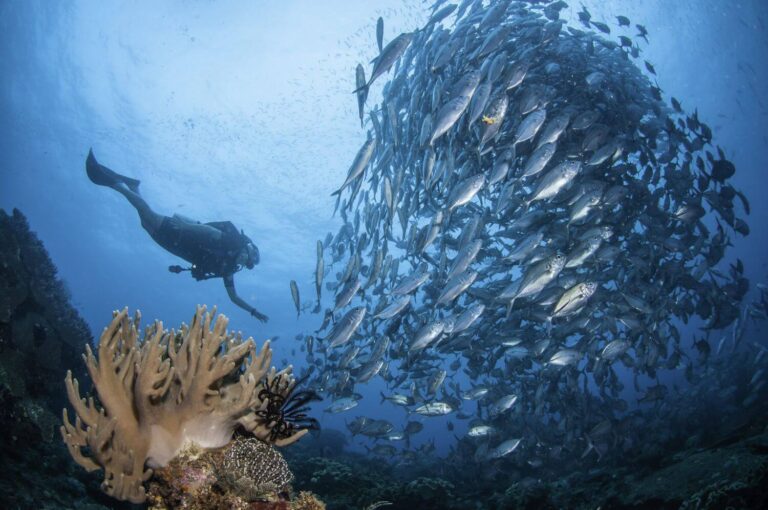
In today’s modern world, Raja Ampat’s precious environment is not without it’s threats. Primarily these come in the form of illegal fishing.
These guys are not local, subsistence fishermen; instead they are trying to make a profit through the lucrative shark fin soup trade and aquatic pet industry, using harmful methods such as explosive blast fishing and going after as many big fish as they possibly can, without giving their populations time to recover.
Usually these fishermen are from some remote part of Indonesia where the local fish and shark populations have become commercially extirpated. In the early 90’s this was starting to become a problem with notable declines in marine life around Raja Ampat, especially sharks and rays.
With persuasive conservation friendly pressure from NGO’s and generous financial support from outside collaborators, the government of Raja Ampat created the first marine protected areas in May 2007, a network of seven areas around Misool, Kofiau, West Waigeo, the Ayu Asia islands and the Dampier Strait.
However, limited resources lead to difficulties with law enforcement and shark slaughter continued in more remote parts of the archipelago.
Then, in 2012, the parliament of Raja Ampat enacted a ground breaking piece of legislation creating a 46,000 sq km (17,760 sq miles) sanctuary for sharks, manta rays, sea turtles, dugongs, certain species of fish – with specific prohibitions agains destructive fishing practices including explosive blast fishing, purse seining, muro-ami netting as well as the collection of fish for aquariums.
It also established heavy penalties for lawbreakers. To ensure proper regulation, the Raja Ampat government left law enforcement and administration of justice to the local villages.
Indeed, a major source of income for many villagers is now as park rangers, patrolling the raja ampat waters to keep them free of illegal fishing, or working on eco resorts.
In this way, the profitable impact of tourism also shows locals that far more money can be made from protecting and promoting marine life for wealthy outsiders, than it can be by permanently overfishing it.
A number of liveaboards donate some or even all of their profits to marine conservation in Raja Ampat, with the most notable example being Coralia.
Raja Ampat Diving Squad DEBRIEFING:
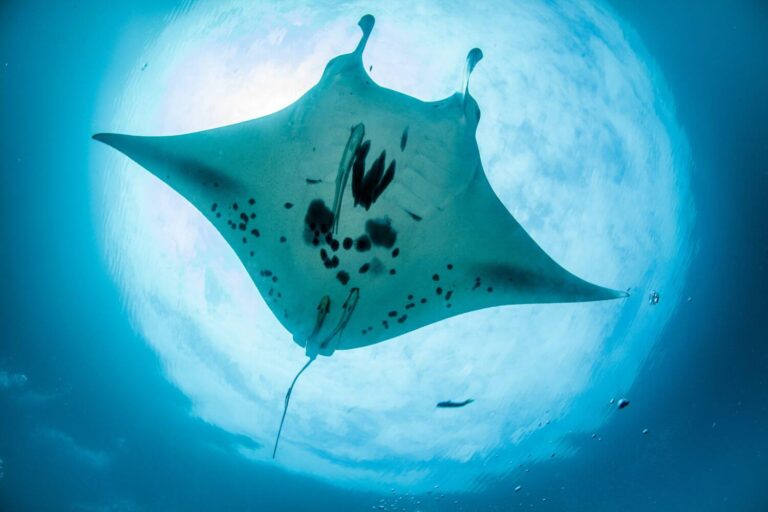
That’s it folks! End of the road. Give yourself a hearty slap on the back. If you’ve made it this far, then now you know all about the different regions in Raja Ampat, how to dive there, when to go and much previous scuba diving experience you need.
You’ll also have some grasp of the history and geography of the place as well as being aware of conservation efforts in the area!
I genuinely hope this has answered any and all questions you might have! Don’t forget, you can always send an email to my personal inbox at ajhatton55@gmail.com with any more questions. Peace!

Support the Squad!
Some of the links in our content are affiliate links. This means that if you buy a product, book a liveaboard, book accommodation or purchase insurance, we earn a small commission at no extra cost to you. Thanks!
